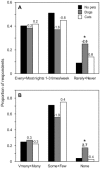When does an alien become a native species? A vulnerable native mammal recognizes and responds to its long-term alien predator
- PMID: 22355396
- PMCID: PMC3280208
- DOI: 10.1371/journal.pone.0031804
When does an alien become a native species? A vulnerable native mammal recognizes and responds to its long-term alien predator
Abstract
The impact of alien predators on native prey populations is often attributed to prey naiveté towards a novel threat. Yet evolutionary theory predicts that alien predators cannot remain eternally novel; prey species must either become extinct or learn and adapt to the new threat. As local enemies lose their naiveté and coexistence becomes possible, an introduced species must eventually become 'native'. But when exactly does an alien become a native species? The dingo (Canis lupus dingo) was introduced to Australia about 4000 years ago, yet its native status remains disputed. To determine whether a vulnerable native mammal (Perameles nasuta) recognizes the close relative of the dingo, the domestic dog (Canis lupus familiaris), we surveyed local residents to determine levels of bandicoot visitation to yards with and without resident dogs. Bandicoots in this area regularly emerge from bushland to forage in residential yards at night, leaving behind tell-tale deep, conical diggings in lawns and garden beds. These diggings were less likely to appear at all, and appeared less frequently and in smaller quantities in yards with dogs than in yards with either resident cats (Felis catus) or no pets. Most dogs were kept indoors at night, meaning that bandicoots were not simply chased out of the yards or killed before they could leave diggings, but rather they recognized the threat posed by dogs and avoided those yards. Native Australian mammals have had thousands of years experience with wild dingoes, which are very closely related to domestic dogs. Our study suggests that these bandicoots may no longer be naïve towards dogs. We argue that the logical criterion for determining native status of a long-term alien species must be once its native enemies are no longer naïve.
Conflict of interest statement
Figures

References
-
- Cox JG, Lima SL. Naivete and an aquatic-terrestrial dichotomy in the effects of introduced predators. Trends in Ecology & Evolution. 2006;21:674–680. - PubMed
-
- Diamond J, Case TJ. Overview: introductions, extinctions, exterminations, and invasions. In: Diamond J, Case TJ, editors. Community Ecology. New York: Harper and Row; 1986. pp. 65–79.
-
- Sih A, Bolnick DI, Luttbeg B, Orrock JL, Peacor SD, et al. Predator-prey naivete, antipredator behavior, and the ecology of predator invasions. Oikos. 2010;119:610–621.
-
- Banks PB, Dickman CR. Alien predation and the effects of multiple levels of prey naivete. Trends in Ecology & Evolution. 2007;22:229–230. - PubMed
Publication types
MeSH terms
LinkOut - more resources
Full Text Sources
Research Materials
Miscellaneous

